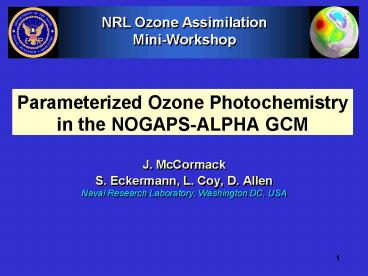Parameterized Ozone Photochemistry in the NOGAPSALPHA GCM - PowerPoint PPT Presentation
1 / 14
Title:
Parameterized Ozone Photochemistry in the NOGAPSALPHA GCM
Description:
NASA EPTOMS observes an ozone 'mini-hole' feature over Western Europe on 14 Jan 2003 ... ECMWF T511L60 ozone forecasts issued on 11 Jan under-predicts the mini-hole. ... – PowerPoint PPT presentation
Number of Views:53
Avg rating:3.0/5.0
Title: Parameterized Ozone Photochemistry in the NOGAPSALPHA GCM
1
Parameterized Ozone Photochemistry in the
NOGAPS-ALPHA GCM
NRL Ozone Assimilation
Mini-Workshop
- J. McCormack
- S. Eckermann, L. Coy, D. Allen
- Naval Research Laboratory, Washington DC, USA
2
NOGAPS-ALPHA NOGAPS with Advanced Level
Physics-High Altitude
- Motivations for Prognostic Ozone in NOGAPS-ALPHA
- Improved satellite radiance assimilation
- Prognostic ozone feeds into model radiative
heating calcs - ? Improved forecasts
- Model Configuation
- Model top at 0.005 hPa (z85 km)
- T79 T239 spectral truncation
- CLIRAD radiation scheme currently uses 2D O3
- New 3D prognostic ozone features
- spectral transport
- GMAO GEOS4 Initialization
- Linearized O3 photochemistry
3
Linearized O3 Photochemistry Scheme for
NOGAPS-ALPHA
df dt
(P-L) f,T,cO3, we can obtain a Taylor
If we assume
series expansion about a mean state (fo , To ,
co) after Cariolle and Déqué 1986 (CD86) and
McLinden et al. 2000 (LINOZ)
1 2 3 4
- Photochemistry Parameters (y,z,t Lookup Tables)
- Mean/Equilibrium Production-Loss (P-L)0
- Photochemical Relaxation Timescale t
-d(P-L)/df0-1 - Temperature Perturbation Coefficient d(P-L)/dT0
- Overhead Column O3 Perturbation Coefficient
d(P-L)/dc0
- NOGAPS Fields
- Ozone Mixing Ratio, f
- Temperature, T
- Column O3, c
Climatological Fields 1. Ozone f0(y,z,t) 2.
Temperature T0(y,z,t) 3. Column O3 c03(y,z,t)
NOGAPS-ALPHA prognostic O3 can use photochemistry
parameters of either CD86 (ECMWF) , LINOZ, NRL
CHEM2D, or Goddard (NCEP) ?
inter-comparison of the 4 different
photochemistry schemes
4
O3 photochemistry schemes tested in
NOGAPS-ALPHA
5
Term 1 O3 (P-L) in ppmv/month
LINOZ
Altitude (km)
Altitude (km)
CHEM2D
CD86
Altitude (km)
LINOZ O3 (P-L) above 10 hPa yields large low
ozone bias
6
Term 2 O3 Relaxation Time (Days)
January
CHEM2D
LINOZ
CD86 O3 lifetimes in lower stratosphere are too
short
Latitude
GSFC
CD86
7
SAGE III Ozone Loss and Validation Experiment
(SOLVE 2 Jan - Feb 2003)
8
NOGAPS Hindcasts SOLVE2
- SOLVE2 provided our first opportunity to test new
NOGAPS-ALPHA 3-D O3 initialization, transport
photochemistry. - We compared results from 5-day hindcasts of
interesting ozone events in Jan 2003 using CD86,
LINOZ, and CHEM2D V0, initialized with GMAO or
ECMWF IFS 3D assimilated ozone fields - Overall the best results were obtained with the
CHEM2D V0 scheme, despite the fact it has no
temperature or column ozone terms - For more details see McCormack et al., Atmos.
Chem. Phys., 4, 2401-2423, 2004.
9
68oN, 20oE
ECMWF NGP-passive (dashed) NGP-CHEM2D
NGP-CD86 NGP-LINOZ
10
68oN, 20oE
LINOZ excessive loss above 10 hPa
ECMWF NGP-passive (dashed) NGP-CHEM2D
NGP-CD86 NGP-LINOZ
11
T79L54 LINOZ
T79L54 CHEM2D
TOTAL OZONE 15 Jan 0Z
T79L54 CD86
All 3 different photochemistry schemes yield
similar results for total ozone. In the lower
stratosphere, the very short CD86 O3 relaxation
time (t -d(P-L)/df 0-1) smooths out zonal
structure at mid-latitudes.
12
NOGAPS-ALPHA 20030111_84
EPTOMS
T239L54 CHEM2D
OPERATIONAL ECMWF 20030111_084
- NASA EPTOMS observes an ozone mini-hole
feature over Western Europe on 14 Jan 2003 - Operational ECMWF T511L60 ozone forecasts issued
on 11 Jan under-predicts the mini-hole. - NOGAPS-ALPHA T239L54 hindcast initialized 11 Jan
with GMAO O3 and using V0 CHEM2D scheme captures
mini-hole feature.
T511L60 CD86
13
Including temperature dependence in CHEM2D
scheme V1.0
d(P-L)/dT for March 30o N
CHEM2D V1.0
CD86
LINOZ
14
Summary































